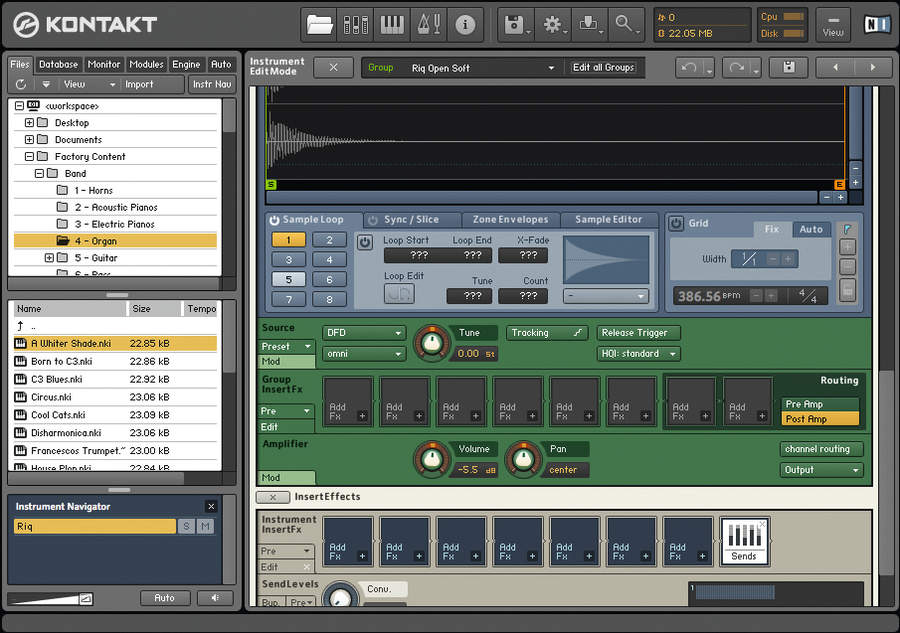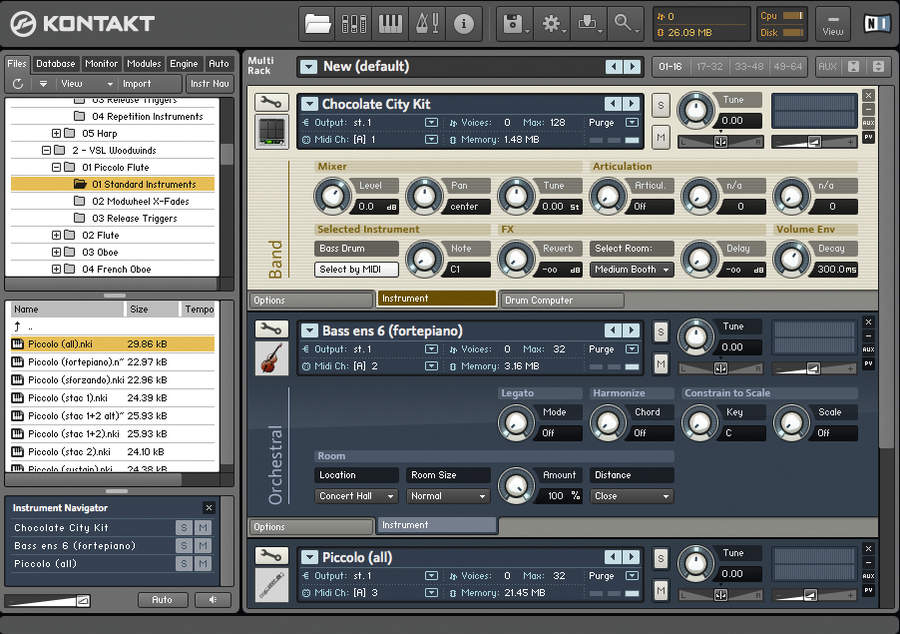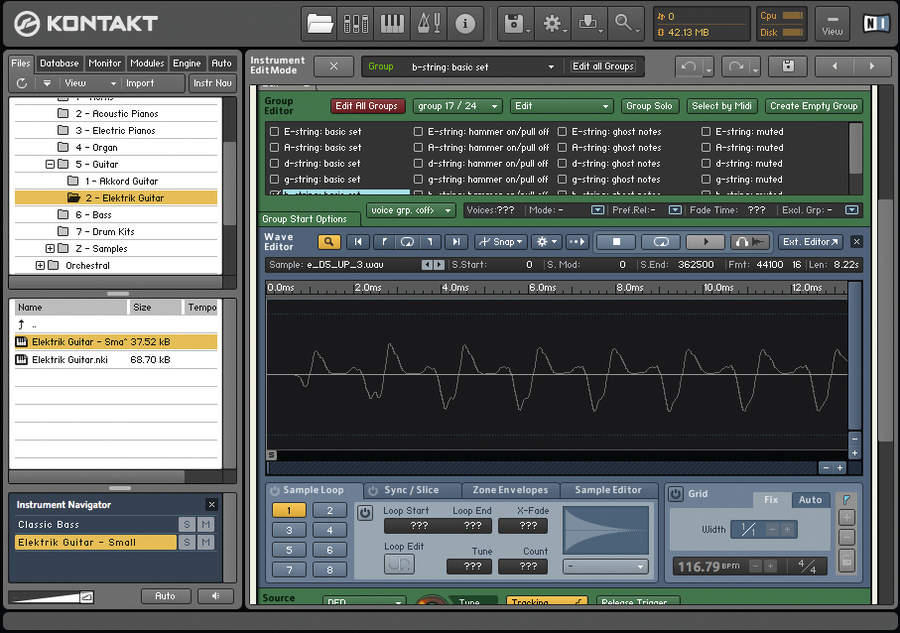MusicRadar Verdict
Kontakt 3 is a great example of the best that today´s music software has to offer. The new features and content mean that it´s great for ‘out of the box´ use and sound design.
Pros
- +
Performance View makes tweaking easy. Drag-and-drop MIDI from sliced loops. Built-in destructive sample editor. Zone Envelopes per sample. Convincing Leslie effect.
Cons
- -
Doesn’t instantly assign samples to embedded pitch.
MusicRadar's got your back



For this, the third generation of its software sampler, Native Instruments has been listening to the pleas and prodding of Kontakt users, and has come up with a fair few keen ideas of its own.
Some, such as full built-in sample editing, might seem obvious, while others, such as the improvements to the user interface, can only be appreciated after some time spent using the software.
Kontakt 3 ships on no less than six DVDs, and installation is a simple if time-consuming process. With a total of 33GB of sample data (17GB of which is new content), it took us around two hours to install the whole thing.
Fortunately, version 3.01's installer offers the option of installing only the individual libraries and plug-in formats that you need.
The interface
The GUI has been given an overhaul, but long-time Kontakt users will nevertheless feel right at home. Once loaded, all of the new instruments sport a Performance View, which enables instant access to various useful parameters without the need to plough through the Instrument Editor.
To give you an example, the Rock Guitar instrument has controls to adjust the cabinet type, distortion drive amount and room ambience, among others. The Kalimba instrument, on the other hand, offers reverb and a chord function.
These Performance Views are created using Kontakt's KSP scripting language, and can be uniquely tailored to each instrument, complete with custom background image, greatly enhancing usability.
Performance Views can also contain nifty features like self-contained drum machines, layering, pattern sequencers and more, and can make individual patches seem like self-contained instruments.
Full editing
While many samplers offer basic waveform editing, NI have always taken the idea to the extreme, building in a full-blown editor with all the trimmings.
Zone Envelopes are probably the most notable addition, being freely drawable envelopes that can be applied to each and every sample. You can do all the things you've come to expect from NI's multi-segmented envelopes, including cutting and copying regions, and snapping regions to grids.
They can be used for all manner of modulations too, not just the basics like volume. You can also loop them and avail yourself of the Randomize Envelope function to create nifty rhythmic modulations for each sample.
One great touch is that your Zone Envelope can be forced to follow the playback speed of the sample; so, if you play the sample an octave higher than its root, the envelope will play back twice as fast to match the change.
While we probably wouldn't go as far as to suggest that you'll have no more need for your copy of ReCycle!, this third incarnation of Kontakt can carry out most of the same types of tasks.
You can chop up your rhythm loops and easily assign slices to individual MIDI notes. Kontakt 3 generates a MIDI file of the slice positions, which can be dragged into your host sequencer. You can also use the Zone Envelopes to individually modulate and process each of the slices.
In addition to the Wave Editor you'll find the dedicated, destructive Sample Editor. This is where you can perform permanent edits, such as fixing DC offset, applying fades, etc.
It enables you to perform many duties that might otherwise require a third-party program. Common tasks such as normalising and fades have dedicated buttons to make the job as painless as possible.
Modulation and more
With so many modulation sources and destinations available onboard, managing your mod routings can be daunting. Thankfully, Kontakt's mod sources now have 'quick jump' buttons that enable you to easily switch between the various sources and their destinations.
There are many more new features to explore, too, and we'd be remiss if we didn't mention the new effects that have been added. The guitar-friendly Twang is sure to please axe-wielders, as will the 11 new cabinet simulations.
Kontakt isn't perfect, though, and there are a few annoyances left over from past versions. It still won't automatically read embedded root note data when dragging a sample into an empty rack, for instance - this requires a trip to the Edit menu.
Another quirk we discovered was that previously embedded loop points weren't displayed correctly at first. However, when we shut the loop function off and then reactivated it, the information was properly displayed, so this is clearly a small bug.
Happily, these aren't major issues, and they don't detract from the fact that Kontakt 3 is a brilliant instrument. Native Instruments continues to perfect its older products, bringing new features and refinements that make upgrading a no-brainer.
In fact, this may indeed be the very best sampler that we've ever used.
MusicRadar is the number 1 website for music makers of all kinds, be they guitarists, drummers, keyboard players, djs or producers...
GEAR: We help musicians find the best gear with top-ranking gear round-ups and high- quality, authoritative reviews by a wide team of highly experienced experts.
TIPS: We also provide tuition, from bite-sized tips to advanced work-outs and guidance from recognised musicians and stars.
STARS: We talk to musicians and stars about their creative processes, and the nuts and bolts of their gear and technique. We give fans an insight into the actual craft of music making that no other music website can.
With its latest free update, Ableton has finally turned Note into the app I always wanted it to be
Technically capable, but struggle to make your tunes sound musical? 5 simple music theory hacks to make your tracks stand out
"Despite its size, it delivers impressive audio quality and premium functions as well as featuring a good selection of inspired sounds": Roland GO:Piano 88PX review










